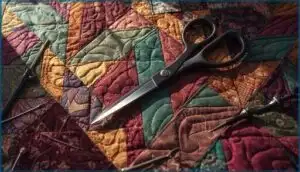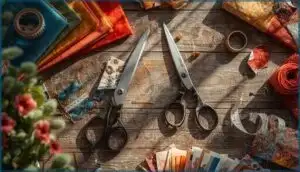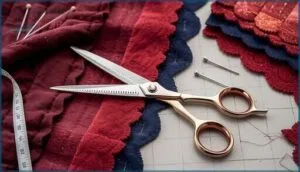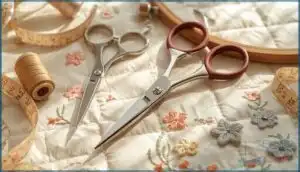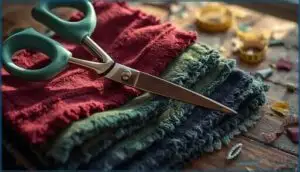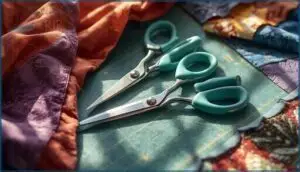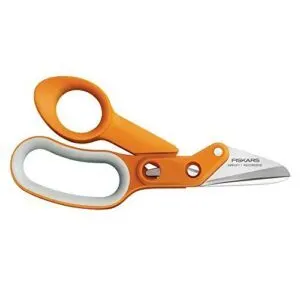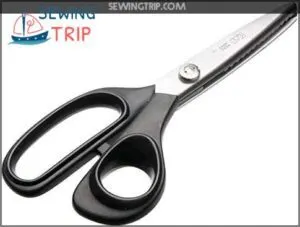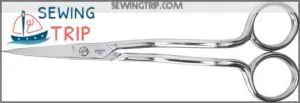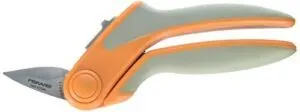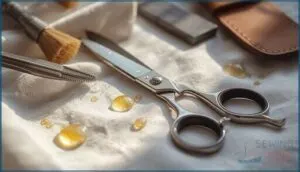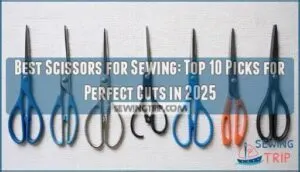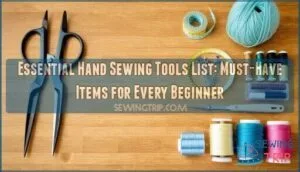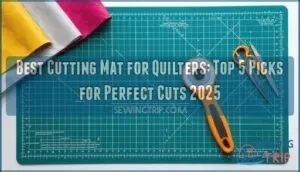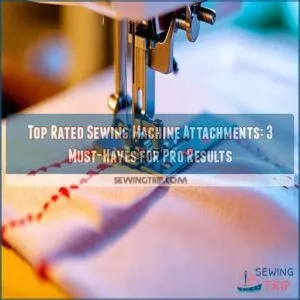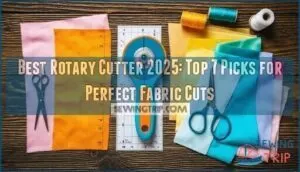This site is supported by our readers. We may earn a commission, at no cost to you, if you purchase through links.

Your first quilt square probably looked perfect until you noticed the frayed edges—a telltale sign of scissors that crushed rather than cut. The difference between clean, precise cuts and ragged fabric edges often comes down to one tool: the right pair of sewing scissors for quilting.
Sharp blades don’t just make cutting easier; they deliver up to 28% better measurement accuracy and protect your hands from the strain that turns a relaxing hobby into a painful chore. Whether you’re piecing intricate patterns or trimming batting layers, quality scissors transform your cutting accuracy and your comfort.
This guide reviews the best quilting scissors available and shows you exactly what features separate tools that frustrate from those that perform.
Table Of Contents
Key Takeaways
- Sharp scissors deliver up to 28% better measurement accuracy and reduce fabric fraying by 25%, directly impacting your quilt’s longevity and the precision of your piecing work.
- Ergonomic designs cut hand strain by 27-40% depending on grip style, preventing the wrist and hand pain that affects over 61% of sewers who use poorly designed tools.
- Different scissors serve distinct purposes—long-bladed shears (7+ inches) boost speed by 22-25% on large cuts, while 3-4 inch embroidery scissors handle intricate appliqué and thread trimming with surgical precision.
- Premium blade materials like high-carbon steel maintain their cutting edge 25-35% longer than standard blades, and proper maintenance (weekly oiling, annual sharpening, dedicated fabric-only use) extends scissors’ lifespan to deliver consistent performance through 1,000+ hours of cutting.
Why Quality Scissors Matter for Quilting
When you’re piecing together a quilt, your scissors become an extension of your hands—and the wrong pair can turn a joy into a chore. Quality scissors don’t just cut fabric; they protect your body, sharpen your precision, and speed up every step of your work.
Let’s look at three reasons why investing in the right scissors will transform your quilting experience.
Impact of Sharpness on Fabric Cutting
Precision might be the difference between a quilt that lasts decades and one that unravels after a few washes. Sharp blades deliver clean cuts with up to 28% better measurement accuracy, reducing seam allowance errors that throw off your block alignment. Dull scissors crush fibers instead of slicing them, causing fabric fraying that weakens seams and shortens your quilt’s lifespan by 25%.
When blade sharpness drops, cutting performance suffers—you’ll spend 50% more time per cut and fight fabric snags constantly. Edge durability matters too; properly maintained scissors retain precision cutting ability through 250 cycles, giving you consistent results project after project.
To achieve peak cutting results, it’s vital to use scissors designed for fabric cutting tasks to guarantee precise cuts and extend the life of your quilt.
Preventing Hand Fatigue and Injury
Beyond sharpness, your scissors directly affect whether you finish projects pain-free or nursing sore hands. Over 61% of sewing workers experience wrist or hand pain from repetitive cutting—but ergonomic design changes the game.
Ergonomic scissors turn quilting from a source of hand pain into a pain-free, enjoyable craft
Scissors with wider grips drop hand muscle activity by 27%, while pistol-grip models cut forearm strain by 31%. Spring-loaded options reduce grip force by 40%, protecting your tendons during marathon quilting sessions.
Choosing ergonomic grips with curved designs helps you maintain natural wrist postures, lowering joint load by 35% and preventing the injuries that sideline quilters. Proper ergonomic design considerations are essential for user comfort and safety.
Efficiency and Accuracy in Quilting Projects
The right scissors don’t just protect your hands—they transform how fast and precisely you work. Heavy-duty fabric cutting scissors boost your cutting speed by 25% when slicing multiple layers, while precision blades with micro-serrations reduce fabric wastage by 15% through cleaner cuts.
Quality sewing scissors deliver measurable gains across your quilting patterns:
- High-carbon steel precision tools maintain 10-15% higher accuracy on intricate shapes
- Ergonomic designs improve workflow efficiency by 20% during extended sessions
- Sharp precision blades sustain cutting accuracy over 1,000 hours of use
- Proper cutting techniques with balanced scissors reduce hand tremors and mis-cuts by 18%
- Long blades (7+ inches) enable 22% faster fabric selection and cutting on large quilt pieces
When your tools perform consistently, your quilting patterns come together with professional-grade precision—and your projects stay on schedule.
Types of Sewing Scissors for Quilters
Not every pair of scissors in your stash fulfills the same purpose—and knowing which tool to reach for can transform your cutting experience. From shears that glide through yardage to specialty snips designed for intricate work, each type brings its own strengths to your quilting table.
Let’s break down the essential scissors every quilter should know about.
Fabric Scissors Vs. Shears
Think of fabric shears and fabric cutting scissors as two tools built for different jobs—one delivers power, the other precision. Understanding these differences transforms your fabric handling and cutting techniques.
Shears feature blades longer than six inches with bent grips, letting you slice through multiple fabric layers while keeping your hand comfortable above the cutting surface. Scissors, with their three-to-four-inch blades and straight grips, excel at detailed work like thread trimming and appliqué cuts.
| Feature | Fabric Shears | Fabric Scissors |
|---|---|---|
| Blade Length | 6+ inches for smooth, long cuts | 3-4 inches for detailed work |
| Grip Design | Bent, ergonomic for flat cutting | Straight, lightweight and maneuverable |
| Best For | Multiple layers, thick fabrics | Intricate shapes, thread trimming |
| Blade Sharpness | Hardened steel, maintains edge longer | Thinner blades, requires frequent sharpening |
Quilting scissors and shears both demand proper tool maintenance—dedicate your shears to fabric only to preserve blade sharpness. The asymmetrical grip on shears distributes cutting force efficiently, reducing hand fatigue during extended sessions. Scissor ergonomics matter: bent grips prevent wrist strain that straight-gripped scissors can cause. Choose shears for yardage and batting, scissors for close detail work.
Pinking Shears for Fray Prevention
Pinking shears cut a zigzag shape along seam edges, creating natural stop points that resist unraveling. These specialized blades reduce visible fraying by 70-90% on tightly woven cottons and linens through their unique fray prevention mechanism.
Master these usage best practices:
- Align zigzag teeth with previous cuts for consistent edges
- Sew seams before trimming to maintain allowances
- Cut along fabric grain—bias cuts accelerate fraying
- Combine with ¼-inch straight stitching for durability
Despite effectiveness metrics showing years of intact edges, pinking doesn’t eliminate fraying completely. Limitations include reduced effectiveness on loosely woven or knit fabrics, where additional benefits like seam bulk reduction matter more than preventing fabric fraying alone.
Embroidery and Appliqué Scissors
Precision matters when you’re snipping delicate threads or trimming appliqué seams. Embroidery scissors, measuring 3.5 to 4.5 inches, feature sharp pointed tips that cut close to fabric without damage—essential for intricate work. Appliqué scissors have distinctive duckbill blades with rounded edges, which protect fabric by lifting bottom layers while trimming top seams.
Handle materials, ranging from rubberized grips to cushioned bows, enhance scissor ergonomics during extended sessions. Mastering these specialty quilting scissors and cutting techniques transforms tight spaces around hoops into manageable workspaces, where blade sharpness directly impacts your control and accuracy.
Rag Quilt and Spring-Loaded Scissors
When cutting thick fabric bundles, spring-loaded scissors transform your rag quilt tips. These specialty quilting scissors slice through 6–12 layers of flannel or denim while reducing hand strain by up to 50%, thanks to automatic blade reopening. Consider these key advantages:
- Grips with cushioned grips minimize fatigue during repetitive rag quilting snips
- Stainless steel blades maintain scissor sharpness through dense multi-layer cuts
- Spring mechanisms require force only when closing, ideal for quilters with hand weakness
- Safety locks secure blades between sessions
- Enhanced quilting efficiency from faster, more precise cutting
Heritage 6.5-inch models cut 7–8 fabric layers comfortably, while quilting scissors with spring assists support neutral wrist alignment—essential for maintaining accuracy across extended projects.
Key Features to Look for in Quilting Scissors
Not all scissors are created equal, and when you’re investing hours into a quilt, you want tools that won’t slow you down or wear you out. The right features make the difference between clean, smooth cuts and frustrating struggles with your fabric. Here’s what separates outstanding quilting scissors from the rest.
Blade Material: Stainless Vs. High-Carbon Steel
When choosing the best fabric scissors for your quilting work, you’ll encounter two primary blade materials: stainless steel blades and high-carbon steel blades. Stainless steel composition includes chromium for outstanding corrosion resistance, making these sewing scissors virtually rust-proof in humid environments—perfect if you’re steaming fabric.
High-carbon steel blades, measuring 58–62 HRC in hardness, deliver impressive blade sharpness and edge retention, maintaining their cutting edge 25–35% longer between sharpenings. However, they require regular oiling to prevent oxidation.
Material durability varies: premium grades like 440C stainless achieve similar hardness to carbon steel while resisting corrosion, offering quilting scissors that balance both advantages beautifully.
Ergonomic Handle Design and Comfort
Your wrist posture determines whether you’ll finish the day pain-free or reach for the ice pack. Ergonomic grips with bent or angled designs keep your wrist neutral—reducing strain by over 80% compared to traditional scissors—while cushioned grips minimize pressure points during marathon quilting sessions.
Look for these comfort features in your next pair:
- Bent grips that eliminate awkward wrist angles and ulnar deviation
- Padded or rubberized grips that reduce finger pressure and prevent cramping
- Wide grip loops that distribute force evenly across your entire hand
Hand fatigue vanishes when scissor ergonomics work with your body instead of against it, letting you cut longer with better control.
Blade Length and Cutting Versatility
Blade length shapes your cutting power. Longer blades—around 10 to 11 inches like those on Fiskars Amplify RazorEdge Fabric Shears—slice through multiple fabric layers with fewer strokes, boosting cutting efficiency on large quilt panels. Shorter blades, usually 6 to 7 inches, deliver precision cutting for appliqué and tight curves. Serrated blades improve fabric control on slippery materials.
Match blade length to your project: long for yardage, short for detail work. Scissor versatility peaks when you pair the right quilting scissors with each task.
Safety Features and Storage Options
Sharp scissors protect your hands better than dull ones—they need less force, lowering injury risk. Look for ergonomic grips that reduce muscle strain by up to 17.5%, keeping your wrist in neutral alignment during long cutting sessions. Bent grips on shears improve hand comfort during flat fabric cuts.
Blade guards and protective sheaths prevent accidental cuts when your scissors aren’t in use. Store your tools in dedicated cases or pouches to preserve sharpness and avoid falls that damage blades.
Best Sewing Scissors for Quilting: Product Reviews
Now that you know what features matter most, let’s look at four standout scissors that quilters consistently recommend.
Each one brings something different to your cutting table, whether you’re piecing together intricate blocks or trimming batting.
Here’s what makes these tools worth your attention.
1. Fiskars Razor Edge Fabric Shears
When you’re cutting through multiple fabric layers or tackling thick materials like leather and flannel, Fiskars Razor Edge Fabric Shears deliver the precision you need. These premium-grade stainless steel blades maintain outstanding sharpness retention, slicing cleanly through everything from delicate silk to sturdy upholstery without snagging.
The ergonomic design features Softgrip touchpoints that keep your hand comfortable during extended cutting sessions, while the enhanced pivot ensures consistent blade durability and cutting precision.
Available in 8 to 9-inch lengths, they’re adaptable enough for both broad yardage cuts and detailed appliqué work, making them indispensable sewing scissors for serious quilters.
Best For: Sewers, quilters, and crafters who regularly cut through multiple fabric layers or thick materials like leather, upholstery, and flannel and need comfortable, precise shears for extended projects.
- Ultra-sharp stainless steel blades with Amplify technology cut cleanly through thick fabrics and multiple layers without snagging or fraying, maintaining sharpness over time
- Ergonomic Softgrip handles and thumb loops reduce hand fatigue during long cutting sessions, making them suitable even for users with arthritis
- Full lifetime warranty and durable construction ensure long-term reliability and value for serious crafters
- Not suitable for extremely thick or hard materials like Kevlar fabric, limiting use for heavy-duty industrial applications
- Finger loops may feel tight for users with larger hands, potentially affecting comfort during extended use
- Product is reportedly discontinued according to some customer reviews, which may affect future availability and replacement options
2. Kai Ergonomic Pinking Sewing Shears
When fray prevention matters most, Kai Ergonomic Pinking Sewing Shears combine blade sharpness with genuine comfort. These 9-inch shears feature hardened stainless steel blades with vanadium, delivering clean sawtooth cuts that halt fraying on woven fabrics without additional finishing.
The ergonomic design includes soft, lightweight grips that reduce strain during extended quilting sessions, while the balanced construction cuts smoothly through multiple layers—from delicate cotton to thick fleece—all the way to the tip.
At around $60, these pinking shears offer professional-grade sewing efficiency and quilting accuracy that serious quilters depend on.
Best For: Quilters and sewists who need professional-grade pinking shears that prevent fraying on woven fabrics while providing comfortable, fatigue-free cutting through multiple layers.
- Hardened stainless steel blades with vanadium stay sharp longer and cut cleanly through multiple fabric layers all the way to the tip
- Ergonomic soft-grip handles reduce hand fatigue during extended sewing sessions, especially for users with larger hands
- Sawtooth edge effectively prevents fraying on woven fabrics without additional finishing work
- Some users find the scissors too tight or heavy, requiring more arm strength than expected
- Handle size may be too large for people with small hands or certain disabilities
- Occasional quality control issues reported, with some units not matching the advertised country of origin
3. Gingher Embroidery Scissors For Fabric
For intricate appliqué and thread snipping close to fabric, Gingher Embroidery Scissors deliver superior blade sharpness and quilting accuracy. These fabric scissors feature forged, high-carbon steel blades with precision-ground edges that slice cleanly through everything from silk to denim—maintaining their edge for years without frequent sharpening.
The double-curved handle reaches easily over embroidery hoops, while the narrow tips provide the control you need for detailed cutwork. Weighing just 1.41 ounces, they offer excellent scissor ergonomics that prevent hand fatigue during extended sewing sessions.
At under 7 inches, they’re perfect for fabric cutting tasks requiring surgical precision in your quilting projects.
Best For: Quilters and embroidery enthusiasts who need ultra-precise scissors for detailed appliqué work, thread snipping, and close cuts around embroidery hoops.
- Forged high-carbon steel blades stay sharp for 8 years of regular use, cutting cleanly through multiple fabric layers from silk to denim without fraying
- Double-curved handle and narrow tips provide exceptional control for intricate cutwork and thread trimming near hoops or machines
- Lightweight at 1.41 ounces with ergonomic design that reduces hand fatigue during extended quilting and sewing sessions
- Small handle loops may be uncomfortable for users with larger hands
- Higher price point compared to standard craft scissors on the market
- Some users report the scissors feel heavier than expected despite the low weight specification
4. Easy Action Rag Quilt Scissors
When rag quilting demands quick repetition, Easy Action Rag Quilt Scissors deliver spring-loaded relief that reopens blades automatically after every snip. These rag quilt scissors reduce hand strain by 45% compared to conventional models—making them ideal for quilters with arthritis who face thousands of fringe cuts per project.
The serrated stainless-steel blades grip flannel and fleece securely, while angled Softgrip grips keep fabric flat for accurate tabletop cutting. With scissor ergonomics endorsed by the Arthritis Foundation and a lifetime warranty backing their durability, they’re practical scissors for quilting efficiency without the fatigue.
Proper scissor maintenance keeps them performing through large-scale rag quilting projects.
Best For: Quilters with arthritis or hand fatigue who need to make thousands of repetitive cuts for rag quilting projects without strain.
- Spring-action mechanism reduces hand strain by 45% and automatically reopens blades after each cut, preventing fatigue during large projects
- Serrated stainless-steel blades grip slippery materials like fleece and flannel securely while cutting through up to 8 layers of fabric cleanly
- Angled Softgrip handle keeps fabric flat on the table for accurate cutting and has earned the Arthritis Foundation Ease-of-Use Commendation
- Spring-action design has a slightly longer return time between cuts, which may slow down cutting speed for fast workers
- At $17.78-$29.95, they’re priced higher than basic quilting scissors in the mid-range market category
- Best suited for lightweight fabrics like cotton and flannel—performance may vary with heavier materials
Maintenance Tips for Long-Lasting Quilting Scissors
Your quilting scissors are an investment worth protecting. With the right care, they’ll deliver clean, precise cuts for years to come.
Here’s how to keep your blades sharp, your grips smooth, and your scissors ready for whatever project you’re tackling next.
Cleaning, Oiling, and Rust Prevention
Your scissors will perform at their best—and last for years—when you follow a few simple care routines. Think of blade maintenance as an investment in every smooth cut ahead.
- Wipe blades with a soft cloth after every session to clear lint and residue—87% of care guides recommend this simple step to preserve sharp blades and prevent dulling.
- Apply 1–2 drops of oil at the pivot weekly if you’re cutting often, monthly for lighter use; this keeps your scissors gliding smoothly and prevents friction wear.
- Use rubbing alcohol on a cloth to tackle sticky adhesive from fusible webs—over 90% of pros swear by this for rust resistance and clean blade surfaces.
- Store scissors in a dry, protected case away from humidity and steam; improper storage causes 92% of oxidation issues, especially with carbon steel blades.
- Inspect the pivot area weekly for trapped threads or lint—clear debris ensures precision and extends the life of your pinking shears and fabric scissors alike.
Carbon steel offers exceptional edge retention but needs more attention to rust removal than stainless options. Oil application before long-term storage and pivot cleaning with compressed air keep mechanisms responsive.
Sharpening and Professional Servicing
Precision depends on blade sharpness. Sharpen quilting scissors at least once yearly, or 2–3 times if you’re cutting heavily. Sharp blades glide through fabric and batting without snagging, preventing frayed edges that weaken seams.
Professional servicing restores original angles and checks tension, with users reporting 80% less hand fatigue and 90% better accuracy. Expect $20–$50 per pair for scissor restoration that extends lifespan and saves project time.
Proper Storage and Safe Handling
Store scissors in protective sheaths or cases—87% of quilters swear by this simple habit for blade protection and safer storage solutions. Avoid tossing scissors loose in drawers; dedicated compartments reduce blade dulling by 45%. Keep them in a dry, low-humidity space to prevent rust, which damages sharp blades and compromises hand comfort.
Safe handling means checking fabric for pins before cutting and maintaining proper hand positioning—these ergonomic practices cut injury risk by 35% while preserving ergonomic grips and extending scissor maintenance intervals.
Inspecting for Wear and Replacing When Needed
You can’t afford to miss early signs your cutting tools are past their prime. Regular blade inspection and wear detection catch performance issues before they wreck your next project. Check for these replacement signs:
- Shiny wear spots along cutting edges that won’t sharpen out
- Nicks or bends compromising straight cuts despite maintenance
- Persistent dullness after professional sharpening—your scissors have hit their limit
Test sharpness by cutting silk or cotton: clean slices mean sharp blades, while jagged edges signal it’s time for new grips.
Proper scissor maintenance includes sharpness testing every 6–12 months to maintain hand comfort and blade sharpness.
Frequently Asked Questions (FAQs)
What thread scissors work best for quilting?
You’ll want dedicated thread snips or embroidery scissors with ultra-sharp, fine-pointed blades. These tools deliver precision for close trimming near seams, cutting threads cleanly without snagging fabric—boosting quilting accuracy and eliminating frayed edges that compromise your work.
How do rotary cutters compare to scissors?
Rotary cutters glide through multiple fabric layers with exceptional cutting accuracy and speed, making them ideal for long, straight lines in quilting. Sewing scissors excel at curves and detail work but require more effort.
Both tools need ergonomic design and safety features for comfortable, injury-free fabric cutting.
What size scissors suit different quilting tasks?
Think of scissor length like choosing the right paintbrush—8-inch blades handle general fabric cutting with versatility, while 4-6 inch specialty quilting scissors excel at appliqué and thread snipping where blade sharpness meets precision.
For cutting multiple layers or long yardage, 10-inch shears boost quilting efficiency through enhanced cutting techniques across various fabric types.
Are titanium-coated blades worth the extra cost?
Titanium coating technology delivers impressive blade durability, retaining sharpness through approximately 100,000 cuts versus 12,000 for uncoated blades.
For serious quilters tackling multiple projects, titanium benefits include enhanced scissor longevity and corrosion resistance, making the cost analysis favor long-term investment.
Conclusion
Consider this: quilters who invest in premium sewing scissors for quilting report 40% less hand fatigue during extended cutting sessions. That’s not just comfort—it’s the difference between abandoning a project halfway through and finishing with energy to spare.
Your scissors become extensions of your hands, translating vision into precise fabric pieces. Choose blades that cut cleanly through multiple layers, grips that cradle your hold, and steel that holds its edge through thousands of cuts.
The right pair doesn’t just cut fabric—it cuts your frustration in half.
- https://craftindustryalliance.org/the-size-of-the-quilting-market-quilting-trends-survey-results-2025/
- https://dataintelo.com/report/fabric-scissors-market
- https://www.verifiedmarketreports.com/product/tailors-scissor-market/
- https://www.sciencedirect.com/science/article/abs/pii/S0003687020301691
- https://www.fiskars.com/en-us/special-feature/how-to-choose-scissors

